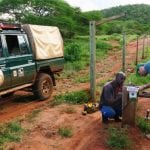Low-power wide-area networks — LPWANs — are finding application in everything from tracking rhinos in Tanzania to monitoring water quality in Ireland
The sun beats down on the dried Tanzanian soils. Dust is slowly settling back down to the ground in the wake of a parade of tourists’ vehicles, which are now disappearing over the horizon. It’s dry season in the Serengeti National Park, and safari trucks are groaning under the weight of excited visitors.
The park, a World Heritage Site, draws tourists from all over the world. Its ecosystem is carefully managed by hard-working park rangers — a delicate balancing act between wildlife promotion and preservation made even more daunting by poachers in pursuit of the endangered eastern black rhino.
Protecting rhinos from poachers has always been an integral part of park management. While it’s still a complicated and highly skilled endeavor, it’s been made a little easier thanks to recent advances in data communications technology. Using geolocation sensors implanted in the rhinos’ horns and novel wireless telecommunications technology known as a low-power wide-area network (LPWAN), rangers can track the Serengeti’s rhinos from a central location, then concentrate their surveillance efforts where the animals are at any given time.

